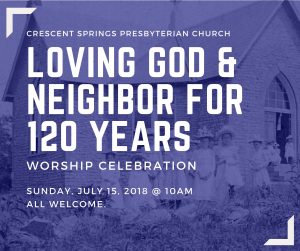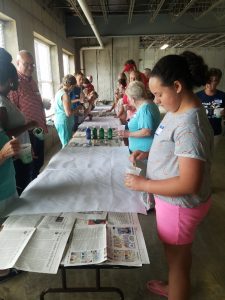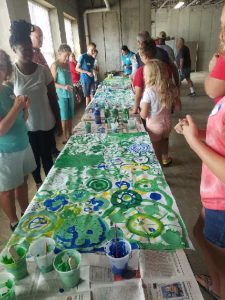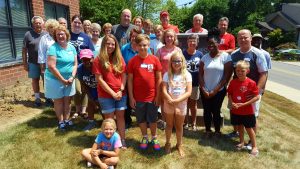 What does it take to build a church?
What does it take to build a church?
My mind jumps immediately to bricks and blueprints. To strategic plans and neat membership lists. To important dates and significant contributions.
CSPC is celebrating its 120th anniversary this year, and the historian in me wants a neat, organized way to tell our history. I could make a list of individual families and donations, discrete events and culture shifts, building expansions and when certain programs were inaugurated.
But the theologian in me knows that building a church isn’t as neat and orderly as that. This church is more than a list of names and dates and donations. This church is more than brick upon brick. It’s the living creation of generations of God’s children.
On July 14, our actual anniversary, the church gathered to celebrate our history and welcome in our future. We sang songs, played games, worshipped, and made art together. Members from two to eighty-two gathered to get to know each other better. It was an amazing day of laughter, memory, and hope.
 Towards the end of the day, we gathered around three blank canvases to make new sanctuary banners together, using a method called circle painting. As we were painting, I realized that this was a far better image of what it takes to build up a church than anything architectural.
Towards the end of the day, we gathered around three blank canvases to make new sanctuary banners together, using a method called circle painting. As we were painting, I realized that this was a far better image of what it takes to build up a church than anything architectural.
First off, circle painting takes a group of people. No one is the “master artist;” no one has the superior vision or a bigger piece of the canvas. Like church, it takes everyone working together to create the finished piece of art. It’s not the pastor, or the longest-serving member, or the biggest donor who’s most important. Everyone participates together. Everyone is needed.
However, when you have a group of people all painting the same canvas, it’s likely to end up as a chaotic mess. With circle painting, all participants make circle shapes on the canvas. Even though everyone paints differently—someone may choose loops, another spirals, another dots—echoing the same shape gives the painting coherency. Church is like this too. We all have different styles, as artists and as Christians. But we have a broad vision—to be the body of Christ in the world—and even though we all live that out differently, our common faith gives us coherency. It is that constant interplay of diversity and unity that makes the painting—and the church—so vibrant.
There’s a double meaning in the phrase “circle painting”—not only do participants paint circles, but they move in a circle around the canvas, painting over and around what other people have done, adding their own flair and details. At the end of the process, you can’t tell who did what. The artists layer their creations over each other, building on each other’s creativity. I can’t help but think this is how churches are really built. We move around each other, building on each other’s wisdom, and courage, and vision, and actions, until nobody has ownership anymore, and the church becomes a beautiful collection of “us.” I could peel back the layers of our history, figure out who taught Sunday School when, who donated money for what, who was the first to think of our ministry to students. There  would be some value in that. But it’s so much more beautiful to see how the generations of this church have built on each other’s faith, until we have a product that is far, far more than the sum of its parts.
would be some value in that. But it’s so much more beautiful to see how the generations of this church have built on each other’s faith, until we have a product that is far, far more than the sum of its parts.
God is our canvas. God is the foundation on which we build the church. But each one of us brings our dreams, our faith, our hopes, our creativity, our passions, and we share them with each other, and we build over and around each other, and what we create is messy—no doubt about it—but it’s beautiful too.
As we finished up painting, I heard some folks joking about how they’d managed to get paint on themselves. And I found myself grinning, because that is also how church should work—you shouldn’t get to walk away from it without a mark, without a sign that you participated in making something beautiful. We created this church, the generations of the faithful here in Crescent Springs. But it has also made us, changed us.
So what does it take to build a church?
More than bricks, more than membership, more than donations. It takes a willingness to get messy, and give up ownership, and be creative in ways we never thought we were good at. It takes a willingness to share our gifts, and give our all. It takes a willingness to let go of perfect and embrace God’s goodness.
I celebrate 120 years of God’s artists, people who have made Crescent Springs Presbyterian Church the beautiful place it is now. And I look forward to seeing who will make their mark on the canvas next, who will keep circling around the church, who will see some blank spot that needs filling, or color that needs to be added.
We’re a messy, beautiful church. And I wouldn’t have it any other way.




Leave a Reply
Your email is safe with us.